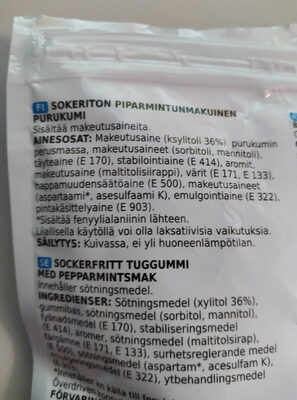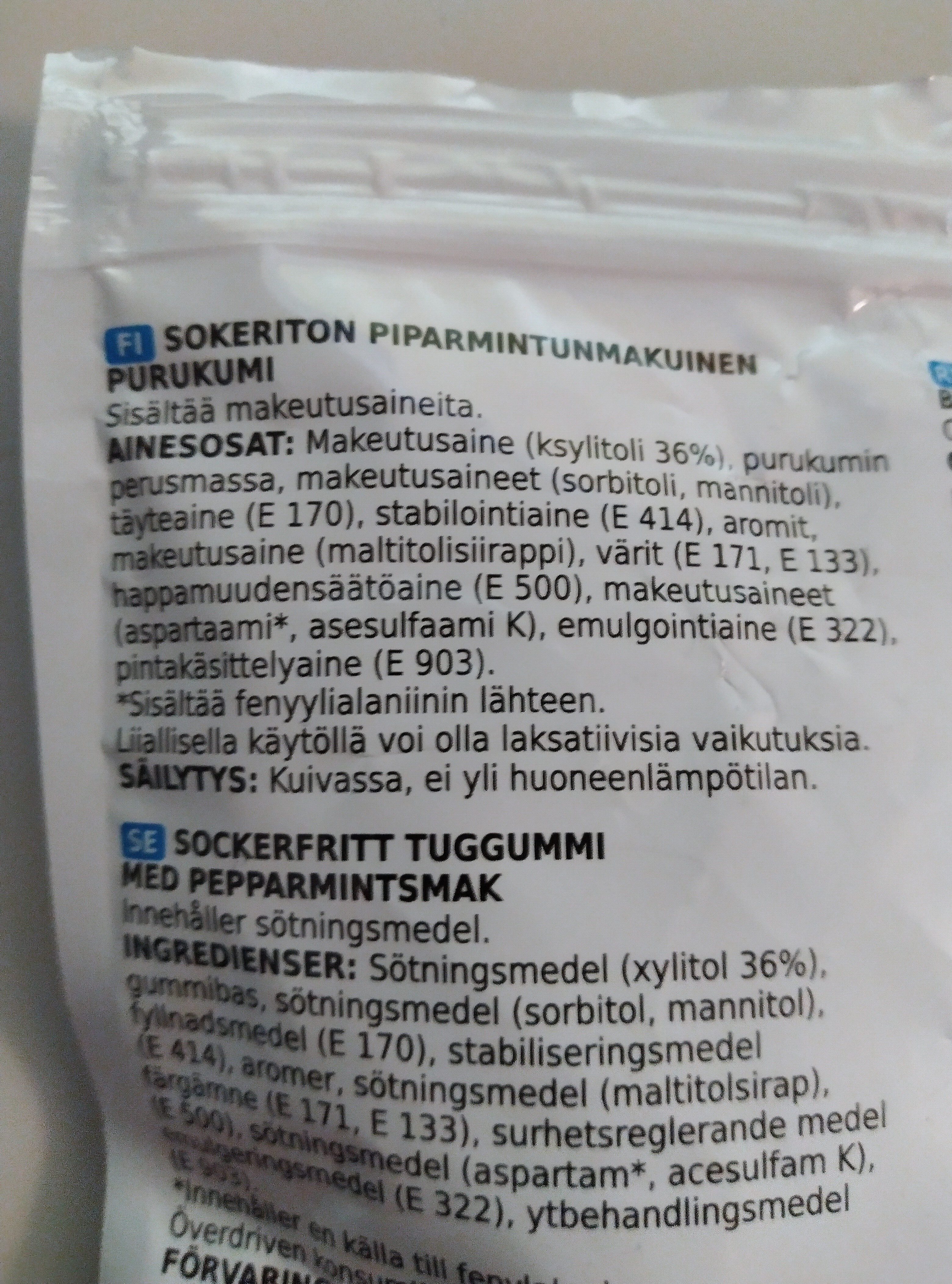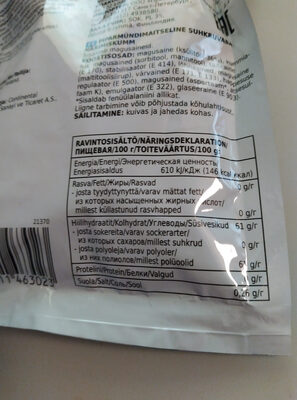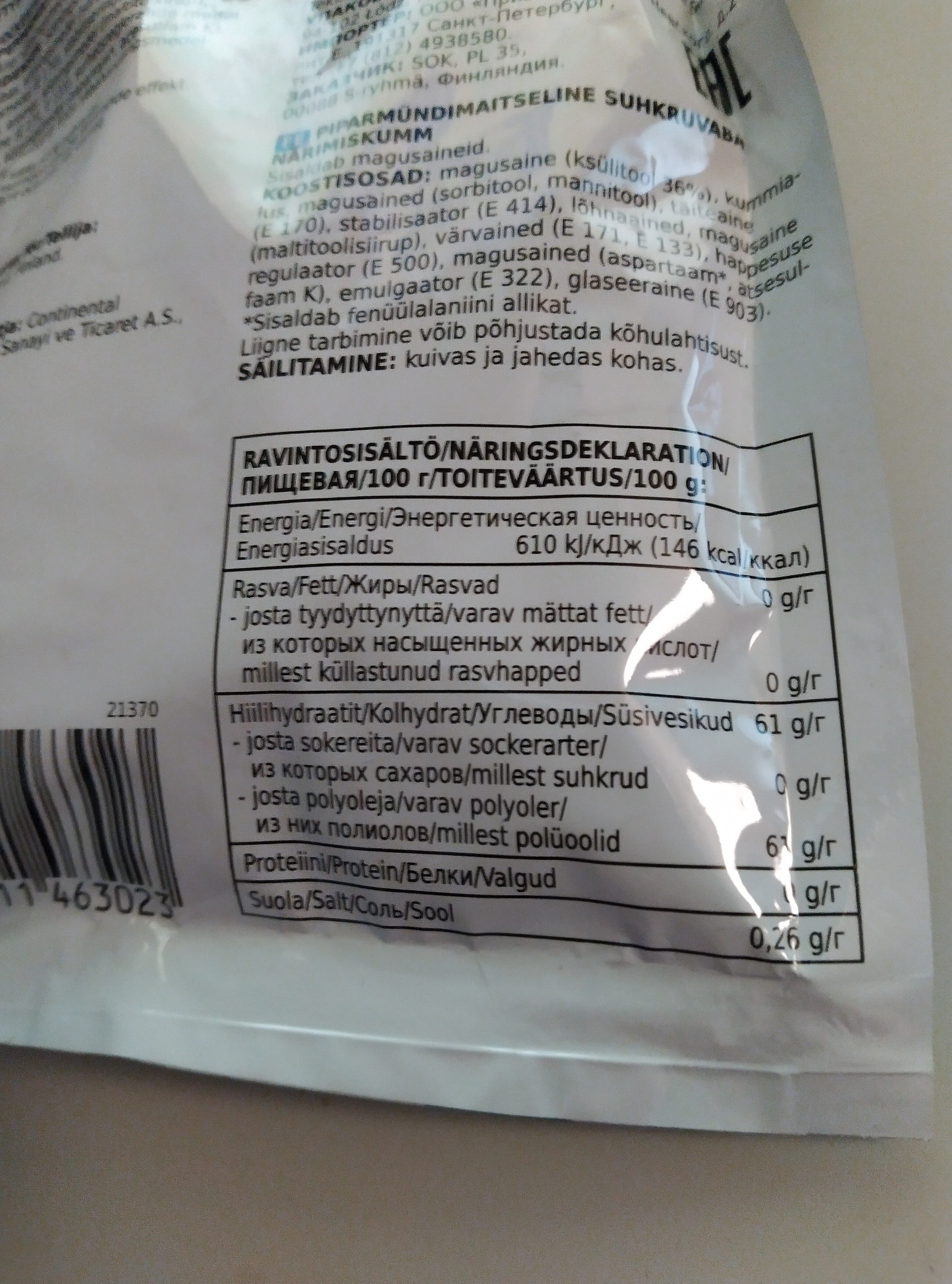Help us make food transparency the norm!
As a non-profit organization, we depend on your donations to continue informing consumers around the world about what they eat.
The food revolution starts with you!
Purukumi Piparminttu Xylitoli - Xtra - 180 g
Purukumi Piparminttu Xylitoli - Xtra - 180 g
This product page is not complete. You can help to complete it by editing it and adding more data from the photos we have, or by taking more photos using the app for Android or iPhone/iPad. Thank you!
×
Streckkod: 7340011463023 (EAN / EAN-13)
Kvantitet: 180 g
Förpackning: en:plastic zip bag
Kategorier: Snacks, Söta snacks, Konfekt, en:Chewing gum, en:Sugar-free chewing gum
Etiketter, certifieringar, utmärkelser: Innehåller en fenylalaninkälla, Överdriven konsumtion kan ha laxerande verkan
Länder där såld: Finland
Matching with your preferences
Hälsa
Ingredienser
-
25 ingredienser
: Makeutusaine (ksylitoli 36%), purukumin perusmassa, makeutusaineet (sorbitoli, mannitoli). täyteaine (E 170), stabilointiaine (E 414), aromit. makeutusaine (maltitolisiirappi), värit (E 171, E 133), happamuudensäätöaine (E 500), makeutusaineet (aspartaami*, asesulfaami K), emulgointiaine (E 322), pintakäsittelyaine (E 903). *Sisältää fenyylialaniinin lähteen. Liiallisella käytöllä voi olla laksatiivisia vaikutuksia.
Food processing
-
Ultra processed foods
Elements that indicate the product is in the 4 - Ultra bearbetade livsmedel och drycker group:
- Tillsats: E133 - Briljantblått FCF
- Tillsats: E170
- Tillsats: E171 - Titandioxid
- Tillsats: E322 - Lecitiner
- Tillsats: E414 - Gummi arabicum
- Tillsats: E420 - Sorbitol
- Tillsats: E421 - Mannitol
- Tillsats: E903 - Karnaubavax
- Tillsats: E950 - Acesulfam k
- Tillsats: E951 - Aspartam
- Tillsats: E965 - Maltitol
- Ingrediens: Fyllnadsmedel
- Ingrediens: Färg
- Ingrediens: Emulgeringsmedel
- Ingrediens: Arom
- Ingrediens: Ytbehandlingsmedel
- Ingrediens: Sötningsmedel
Food products are classified into 4 groups according to their degree of processing:
- Obearbetade eller minimalt bearbetade livsmedel
- Bearbetade kulinariska ingredienser
- Halvfabrikat
- Ultra processed foods
The determination of the group is based on the category of the product and on the ingredients it contains.
Tillsatser
-
E133 - Briljantblått FCF
Brilliant Blue FCF: Brilliant Blue FCF -Blue 1- is an organic compound classified as a triarylmethane dye and a blue azo dye, reflecting its chemical structure. Known under various commercial names, it is a colorant for foods and other substances. It is denoted by E number E133 and has a color index of 42090. It has the appearance of a blue powder. It is soluble in water, and the solution has a maximum absorption at about 628 nanometers.Källa: Wikipedia (Engelska)
-
E170
Calcium carbonate: Calcium carbonate is a chemical compound with the formula CaCO3. It is a common substance found in rocks as the minerals calcite and aragonite -most notably as limestone, which is a type of sedimentary rock consisting mainly of calcite- and is the main component of pearls and the shells of marine organisms, snails, and eggs. Calcium carbonate is the active ingredient in agricultural lime and is created when calcium ions in hard water react with carbonate ions to create limescale. It is medicinally used as a calcium supplement or as an antacid, but excessive consumption can be hazardous.Källa: Wikipedia (Engelska)
-
E171 - Titandioxid
Titanium dioxide: Titanium dioxide, also known as titaniumIV oxide or titania, is the naturally occurring oxide of titanium, chemical formula TiO2. When used as a pigment, it is called titanium white, Pigment White 6 -PW6-, or CI 77891. Generally, it is sourced from ilmenite, rutile and anatase. It has a wide range of applications, including paint, sunscreen and food coloring. When used as a food coloring, it has E number E171. World production in 2014 exceeded 9 million metric tons. It has been estimated that titanium dioxide is used in two-thirds of all pigments, and the oxide has been valued at $13.2 billion.Källa: Wikipedia (Engelska)
-
E322 - Lecitiner
Lecithin: Lecithin -UK: , US: , from the Greek lekithos, "egg yolk"- is a generic term to designate any group of yellow-brownish fatty substances occurring in animal and plant tissues, which are amphiphilic – they attract both water and fatty substances -and so are both hydrophilic and lipophilic-, and are used for smoothing food textures, dissolving powders -emulsifying-, homogenizing liquid mixtures, and repelling sticking materials.Lecithins are mixtures of glycerophospholipids including phosphatidylcholine, phosphatidylethanolamine, phosphatidylinositol, phosphatidylserine, and phosphatidic acid.Lecithin was first isolated in 1845 by the French chemist and pharmacist Theodore Gobley. In 1850, he named the phosphatidylcholine lécithine. Gobley originally isolated lecithin from egg yolk—λέκιθος lekithos is "egg yolk" in Ancient Greek—and established the complete chemical formula of phosphatidylcholine in 1874; in between, he had demonstrated the presence of lecithin in a variety of biological matters, including venous blood, in human lungs, bile, human brain tissue, fish eggs, fish roe, and chicken and sheep brain. Lecithin can easily be extracted chemically using solvents such as hexane, ethanol, acetone, petroleum ether, benzene, etc., or extraction can be done mechanically. It is usually available from sources such as soybeans, eggs, milk, marine sources, rapeseed, cottonseed, and sunflower. It has low solubility in water, but is an excellent emulsifier. In aqueous solution, its phospholipids can form either liposomes, bilayer sheets, micelles, or lamellar structures, depending on hydration and temperature. This results in a type of surfactant that usually is classified as amphipathic. Lecithin is sold as a food additive and dietary supplement. In cooking, it is sometimes used as an emulsifier and to prevent sticking, for example in nonstick cooking spray.Källa: Wikipedia (Engelska)
-
E414 - Gummi arabicum
Gum arabic: Gum arabic, also known as acacia gum, arabic gum, gum acacia, acacia, Senegal gum and Indian gum, and by other names, is a natural gum consisting of the hardened sap of various species of the acacia tree. Originally, gum arabic was collected from Acacia nilotica which was called the "gum arabic tree"; in the present day, gum arabic is collected from acacia species, predominantly Acacia senegal and Vachellia -Acacia- seyal; the term "gum arabic" does not indicate a particular botanical source. In a few cases so‐called "gum arabic" may not even have been collected from Acacia species, but may originate from Combretum, Albizia or some other genus. Producers harvest the gum commercially from wild trees, mostly in Sudan -80%- and throughout the Sahel, from Senegal to Somalia—though it is historically cultivated in Arabia and West Asia. Gum arabic is a complex mixture of glycoproteins and polysaccharides. It is the original source of the sugars arabinose and ribose, both of which were first discovered and isolated from it, and are named after it. Gum arabic is soluble in water. It is edible, and used primarily in the food industry as a stabilizer, with EU E number E414. Gum arabic is a key ingredient in traditional lithography and is used in printing, paint production, glue, cosmetics and various industrial applications, including viscosity control in inks and in textile industries, though less expensive materials compete with it for many of these roles. While gum arabic is now produced throughout the African Sahel, it is still harvested and used in the Middle East.Källa: Wikipedia (Engelska)
-
E420 - Sorbitol
Sorbitol: Sorbitol --, less commonly known as glucitol --, is a sugar alcohol with a sweet taste which the human body metabolizes slowly. It can be obtained by reduction of glucose, which changes the aldehyde group to a hydroxyl group. Most sorbitol is made from corn syrup, but it is also found in nature, for example in apples, pears, peaches, and prunes. It is converted to fructose by sorbitol-6-phosphate 2-dehydrogenase. Sorbitol is an isomer of mannitol, another sugar alcohol; the two differ only in the orientation of the hydroxyl group on carbon 2. While similar, the two sugar alcohols have very different sources in nature, melting points, and uses.Källa: Wikipedia (Engelska)
-
E421 - Mannitol
Mannitol: Mannitol is a type of sugar alcohol which is also used as a medication. As a sugar, it is often used as a sweetener in diabetic food, as it is poorly absorbed from the intestines. As a medication, it is used to decrease pressure in the eyes, as in glaucoma, and to lower increased intracranial pressure. Medically, it is given by injection. Effects typically begin within 15 minutes and last up to 8 hours.Common side effects from medical use include electrolyte problems and dehydration. Other serious side effects may include worsening heart failure and kidney problems. It is unclear if use is safe in pregnancy. Mannitol is in the osmotic diuretic family of medications and works by pulling fluid from the brain and eyes.The discovery of mannitol is attributed to Joseph Louis Proust in 1806. It is on the World Health Organization's List of Essential Medicines, the most effective and safe medicines needed in a health system. The wholesale cost in the developing world is about US$1.12 to 5.80 a dose. In the United States, a course of treatment costs $25 to 50. It was originally made from the flowering ash and called manna due to its supposed resemblance to the Biblical food. Mannitol is on the World Anti-Doping Agency's banned drug list due to concerns that it may mask other drugs.Källa: Wikipedia (Engelska)
-
E500 - Natriumkarbonater
Sodium carbonate: Sodium carbonate, Na2CO3, -also known as washing soda, soda ash and soda crystals, and in the monohydrate form as crystal carbonate- is the water-soluble sodium salt of carbonic acid. It most commonly occurs as a crystalline decahydrate, which readily effloresces to form a white powder, the monohydrate. Pure sodium carbonate is a white, odorless powder that is hygroscopic -absorbs moisture from the air-. It has a strongly alkaline taste, and forms a moderately basic solution in water. Sodium carbonate is well known domestically for its everyday use as a water softener. Historically it was extracted from the ashes of plants growing in sodium-rich soils, such as vegetation from the Middle East, kelp from Scotland and seaweed from Spain. Because the ashes of these sodium-rich plants were noticeably different from ashes of timber -used to create potash-, they became known as "soda ash". It is synthetically produced in large quantities from salt -sodium chloride- and limestone by a method known as the Solvay process. The manufacture of glass is one of the most important uses of sodium carbonate. Sodium carbonate acts as a flux for silica, lowering the melting point of the mixture to something achievable without special materials. This "soda glass" is mildly water-soluble, so some calcium carbonate is added to the melt mixture to make the glass produced insoluble. This type of glass is known as soda lime glass: "soda" for the sodium carbonate and "lime" for the calcium carbonate. Soda lime glass has been the most common form of glass for centuries. Sodium carbonate is also used as a relatively strong base in various settings. For example, it is used as a pH regulator to maintain stable alkaline conditions necessary for the action of the majority of photographic film developing agents. It acts as an alkali because when dissolved in water, it dissociates into the weak acid: carbonic acid and the strong alkali: sodium hydroxide. This gives sodium carbonate in solution the ability to attack metals such as aluminium with the release of hydrogen gas.It is a common additive in swimming pools used to raise the pH which can be lowered by chlorine tablets and other additives which contain acids. In cooking, it is sometimes used in place of sodium hydroxide for lyeing, especially with German pretzels and lye rolls. These dishes are treated with a solution of an alkaline substance to change the pH of the surface of the food and improve browning. In taxidermy, sodium carbonate added to boiling water will remove flesh from the bones of animal carcasses for trophy mounting or educational display. In chemistry, it is often used as an electrolyte. Electrolytes are usually salt-based, and sodium carbonate acts as a very good conductor in the process of electrolysis. In addition, unlike chloride ions, which form chlorine gas, carbonate ions are not corrosive to the anodes. It is also used as a primary standard for acid-base titrations because it is solid and air-stable, making it easy to weigh accurately.Källa: Wikipedia (Engelska)
-
E903 - Karnaubavax
Carnauba wax: Carnauba -; Portuguese: carnaúba [kaʁnɐˈubɐ]-, also called Brazil wax and palm wax, is a wax of the leaves of the palm Copernicia prunifera -Synonym: Copernicia cerifera-, a plant native to and grown only in the northeastern Brazilian states of Piauí, Ceará, Maranhão, Bahia, and Rio Grande do Norte. It is known as "queen of waxes" and in its pure state, usually comes in the form of hard yellow-brown flakes. It is obtained from the leaves of the carnauba palm by collecting and drying them, beating them to loosen the wax, then refining and bleaching the wax.Källa: Wikipedia (Engelska)
-
E950 - Acesulfam k
Acesulfame potassium: Acesulfame potassium - AY-see-SUL-faym-, also known as acesulfame K -K is the symbol for potassium- or Ace K, is a calorie-free sugar substitute -artificial sweetener- often marketed under the trade names Sunett and Sweet One. In the European Union, it is known under the E number -additive code- E950. It was discovered accidentally in 1967 by German chemist Karl Clauss at Hoechst AG -now Nutrinova-. In chemical structure, acesulfame potassium is the potassium salt of 6-methyl-1‚2,3-oxathiazine-4-3H--one 2‚2-dioxide. It is a white crystalline powder with molecular formula C4H4KNO4S and a molecular weight of 201.24 g/mol.Källa: Wikipedia (Engelska)
-
E951 - Aspartam
Aspartame: Aspartame -APM- is an artificial non-saccharide sweetener used as a sugar substitute in some foods and beverages. In the European Union, it is codified as E951. Aspartame is a methyl ester of the aspartic acid/phenylalanine dipeptide. A panel of experts set up by the European Food Safety Authority concluded in 2013 that aspartame is safe for human consumption at current levels of exposure. As of 2018, evidence does not support a long-term benefit for weight loss or in diabetes. Because its breakdown products include phenylalanine, people with the genetic condition phenylketonuria -PKU- must be aware of this as an additional source.It was first sold under the brand name NutraSweet. It was first made in 1965, and the patent expired in 1992. It was initially approved for use in food products by the U.S. Food and Drug Administration -FDA- in 1981. The safety of aspartame has been the subject of several political and medical controversies, United States congressional hearings, and Internet hoaxes.Källa: Wikipedia (Engelska)
-
E965 - Maltitol
Maltitol: Maltitol is a sugar alcohol -a polyol- used as a sugar substitute. It has 75–90% of the sweetness of sucrose -table sugar- and nearly identical properties, except for browning. It is used to replace table sugar because it is half as caloric, does not promote tooth decay, and has a somewhat lesser effect on blood glucose. In chemical terms, maltitol is known as 4-O-α-glucopyranosyl-D-sorbitol. It is used in commercial products under trade names such as Lesys, Maltisweet and SweetPearl.Källa: Wikipedia (Engelska)
-
E965ii - Maltitolsirap
Maltitol: Maltitol is a sugar alcohol -a polyol- used as a sugar substitute. It has 75–90% of the sweetness of sucrose -table sugar- and nearly identical properties, except for browning. It is used to replace table sugar because it is half as caloric, does not promote tooth decay, and has a somewhat lesser effect on blood glucose. In chemical terms, maltitol is known as 4-O-α-glucopyranosyl-D-sorbitol. It is used in commercial products under trade names such as Lesys, Maltisweet and SweetPearl.Källa: Wikipedia (Engelska)
Ingrediensanalys
-
Palmoljefri
No ingredients containing palm oil detected
-
Vegansk status okänd
Okända ingredienser: Gummibas, E170
-
Vegetarisk status okänd
Okända ingredienser: Gummibas, E170
-
Details of the analysis of the ingredients
: Makeutusaine (ksylitoli 36%), purukumin perusmassa, makeutusaineet (sorbitoli, mannitoli), täyteaine (e170), stabilointiaine (e414), aromit, makeutusaine (maltitolisiirappi), värit (e171, e133), happamuudensäätöaine (e500), makeutusaineet (aspartaami, asesulfaami K), emulgointiaine (e322), pintakäsittelyaine (e903)- Makeutusaine -> en:sweetener - percent_min: 36 - percent_max: 36
- ksylitoli -> en:e967 - vegan: yes - vegetarian: yes - percent_min: 36 - percent: 36 - percent_max: 36
- purukumin perusmassa -> en:gum-base - percent_min: 5.81818181818182 - percent_max: 36
- makeutusaineet -> en:sweetener - percent_min: 2.8 - percent_max: 33.3333333333333
- sorbitoli -> en:e420 - vegan: yes - vegetarian: yes - percent_min: 1.4 - percent_max: 33.3333333333333
- mannitoli -> en:e421 - vegan: yes - vegetarian: yes - percent_min: 0 - percent_max: 16.6666666666667
- täyteaine -> en:bulking-agent - percent_min: 0 - percent_max: 25
- e170 -> en:e170 - percent_min: 0 - percent_max: 25
- stabilointiaine -> en:stabiliser - percent_min: 0 - percent_max: 19.3939393939394
- e414 -> en:e414 - vegan: yes - vegetarian: yes - percent_min: 0 - percent_max: 19.3939393939394
- aromit -> en:flavouring - vegan: maybe - vegetarian: maybe - percent_min: 0 - percent_max: 5
- makeutusaine -> en:sweetener - percent_min: 0 - percent_max: 5
- maltitolisiirappi -> en:e965ii - vegan: yes - vegetarian: yes - percent_min: 0 - percent_max: 5
- värit -> en:colour - percent_min: 0 - percent_max: 5
- e171 -> en:e171 - vegan: yes - vegetarian: yes - percent_min: 0 - percent_max: 5
- e133 -> en:e133 - vegan: yes - vegetarian: yes - percent_min: 0 - percent_max: 2.5
- happamuudensäätöaine -> en:acidity-regulator - percent_min: 0 - percent_max: 5
- e500 -> en:e500 - vegan: yes - vegetarian: yes - percent_min: 0 - percent_max: 5
- makeutusaineet -> en:sweetener - percent_min: 0 - percent_max: 5
- aspartaami -> en:e951 - vegan: yes - vegetarian: yes - percent_min: 0 - percent_max: 5
- asesulfaami K -> en:e950 - vegan: yes - vegetarian: yes - percent_min: 0 - percent_max: 2.5
- emulgointiaine -> en:emulsifier - percent_min: 0 - percent_max: 5
- e322 -> en:e322 - vegan: maybe - vegetarian: maybe - percent_min: 0 - percent_max: 5
- pintakäsittelyaine -> en:glazing-agent - percent_min: 0 - percent_max: 5
- e903 -> en:e903 - vegan: yes - vegetarian: yes - percent_min: 0 - percent_max: 5
- Makeutusaine -> en:sweetener - percent_min: 36 - percent_max: 36
Näring
-
Nutri-Score not-applicable
Not-applicable for the category: Chewing gum
⚠ ️Nutri-Score not applicable for this product category.Could you add the information needed to compute the Nutri-Score?
-
Näringsfakta
Näringsfakta Som såld
för 100 g / 100 mlCompared to: en:Sugar-free chewing gum Fett ? Mättat fett ? Kolhydrat ? Sockerarter ? Fiber ? Protein ? Salt ? Fruits‚ vegetables‚ nuts and rapeseed‚ walnut and olive oils (estimate from ingredients list analysis) 0 %
Miljö
-
Eco-score ej beräknad - Okänd miljöpåverkan
Vi kunde inte beräkna Eco-Score av denna produkt eftersom det saknas vissa data, kan du hjälpa till att slutföra det?Could you add a precise product category so that we can compute the Eco-Score? Lägg till en kategori
Förpackning
-
Packaging with a medium impact
-
Packaging parts
Bag (Plast)
-
Packaging materials
Material % Packaging weight Packaging weight per 100 g of product Plast
-
Transportation
-
Origins of ingredients
Missing origins of ingredients information
⚠ ️ The origins of the ingredients of this product are not indicated.
If they are indicated on the packaging, you can modify the product sheet and add them.
If you are the manufacturer of this product, you can send us the information with our free platform for producers.Add the origins of ingredients for this product Add the origins of ingredients for this product
Report a problem
-
Incomplete or incorrect information?
Category, labels, ingredients, allergens, nutritional information, photos etc.
If the information does not match the information on the packaging, please complete or correct it. Open Food Facts is a collaborative database, and every contribution is useful for all.
Datakällor
Produkt tillagd den av openfoodfacts-contributors
Senast ändrad produktsida på av packbot.
Produktsida också redigerad av off.e5279e6d-2ceb-4bcd-b21d-a50fac7dcca3.






